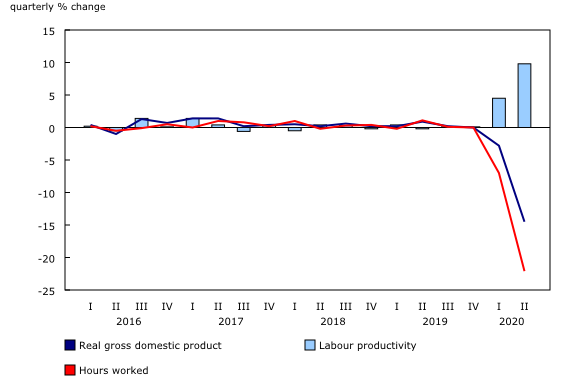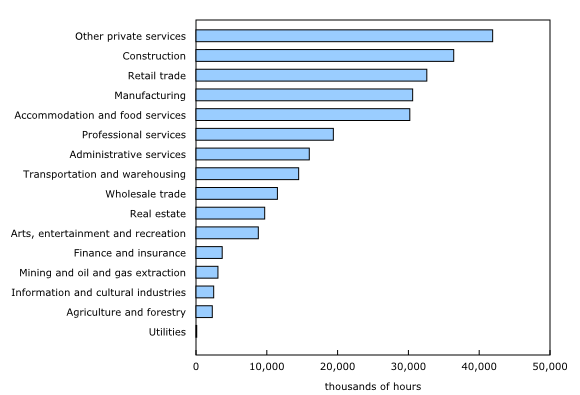Labour productivity, hourly compensation and unit labour cost, second quarter 2020
Archived Content
Information identified as archived is provided for reference, research or recordkeeping purposes. It is not subject to the Government of Canada Web Standards and has not been altered or updated since it was archived. Please "contact us" to request a format other than those available.
Released: 2020-09-02
Second quarter 2020
9.8% 
(quarterly change)
Labour productivity posts strong gain, while hours worked fall at a much faster pace than output
Labour productivity of Canadian businesses rose strongly (+9.8%) in the second quarter, while hours worked fell at a much faster pace than business output. This labour productivity increase was much higher than the previous record growth of 4.5% in the first quarter—in which the first lockdown measures were imposed, in mid-March.
Because the lockdown measures to slow the spread of COVID-19 largely continued until early May, both business output and hours worked saw historic declines—in the double digits—in the second quarter. However, hours worked fell at a much faster pace than business output, resulting in considerable productivity growth.
The stoppage of non-essential activities from mid-March to the end of April because of the pandemic lockdown also led to a record decrease in employment.
Business output posts sharp decline
In the second quarter, real gross domestic product (GDP) of businesses fell sharply (-14.5%), following a 2.8% decrease in the first quarter. This is a 16.7% drop from the second quarter of 2019. Most of the decrease in output was observed in April, when the lockdown was in full force; most activities gradually resumed in some areas of the country in May and June as restrictions were eased. The downward movement was widespread, with output falling in all goods- and service-producing industries. Only the agriculture and forestry sector saw an increase.
Hours worked fall drastically
Hours worked in the business sector fell sharply (-22.1%) in the second quarter. This was more than three times the 7.0% decrease observed in the first quarter. Moreover, hours worked were down 27.5% from the second quarter of 2019.
The second quarter saw a record drop of 22.7% in employment, while hours worked per job rose 0.7%. The number of people who had more than one job fell by almost half (-44.3%), while the number of people who were absent without pay practically doubled (+98.6%).
Hours worked fell significantly in service-producing businesses (-23.1%) and goods-producing businesses (-19.9%); in fact, all major industry sectors posted strong decreases. The largest declines were observed in accommodation and food services (-53.1%); arts, entertainment and recreation (-51.1%); other private services (-29.8%); real estate (-29.3%); construction (-24.2%); and administrative services (-23.7%).
Impact of the COVID-19 pandemic on hours worked in the business sector, second quarter of 2020
The estimates of hours worked in the business sector are primarily based on data from the Labour Force Survey (LFS). Note that for hours worked (used to measure productivity), both main and secondary jobs are considered—not only the main job as in the LFS. The main survey for the reference period that includes the months of April, May and June did not capture the significant job losses outside the reference weeks. To account for those, the estimates of hours lost were adjusted using a compilation of questions added to the LFS questionnaire in May, June and July for the respective reference months of April, May and June. These revisions are reflected in the data on hours worked and related measures (including labour productivity) for the second quarter of 2020.
Because of the lockdown between mid-March and early May, many workers reduced their working hours, while others worked more overtime hours. In the business sector, if only those in the labour force or on paid leave are considered, 345.6 million hours of work were lost in the second quarter, while 82.3 million hours of overtime were worked. The net effect was a loss of 263.3 million hours.
Largest loss in hours observed in other private services
The hours lost vary by industrial sector. In the second quarter, 41.9 million hours were lost in other private services—such as repair and maintenance services, and personal and laundry services—as restrictions were in place for many of these activities. While this was the sector with the largest number of hours lost, others were also heavily affected, such as construction (-36.4 million hours), retail trade (-32.6 million hours), manufacturing (-30.6 million hours), accommodation and food services (-30.2 million hours), and professional services (-19.4 million hours).
The productivity increase in service-producing businesses outpaces the growth in goods-producing businesses
In the second quarter, productivity grew faster in service-producing businesses (up 13.7% after a 4.6% gain in the previous quarter) than in goods-producing businesses (up 8.3% after an increase of 6.4% the previous quarter).
Most major industrial sectors saw growth in their productivity, but to varying degrees. The only sectors to post declines in the second quarter were transportation and warehousing (-13.8%); arts, entertainment and recreation (-6.3%); manufacturing (-1.6%); and mining and oil and gas extraction (-0.7%).
The biggest contributors to the overall productivity gain in the second quarter were real estate (+30.2%), agriculture and forestry (+28.4%), construction (+16.2%), other private services (+11.2%), and retail trade (+10.7%).
Unlike in the first quarter, the effect of reallocating hours between different industry sectors played only a minor role in the strong productivity gain in the second quarter. However, the concentration of hours worked in the largest businesses, which was already observed in the first quarter, intensified in the second quarter. In these businesses, larger economies of scale favour productivity growth.
In the United States, the labour productivity of businesses rose 1.6% in the second quarter, after posting zero growth in the previous quarter. The last time such a high growth rate was observed was the third quarter of 2009. Like in Canada, the real GDP (-11.5%) of American businesses and hours worked (-12.9%) both saw record declines.
Unit labour costs are up considerably in the second quarter
Labour costs per unit of output in Canadian businesses rose 4.1% in the second quarter, after rising 0.7% in the first quarter. The last quarterly increase of this magnitude dates back to the fourth quarter of 1986 (+3.6%).
The very rapid increase in labour unit costs reflects an unprecedented increase in the average compensation per hour worked (+14.3%), which topped the historic productivity gain (+9.8%).
In the second quarter, average hourly compensation rose 16.5% in service-producing businesses and increased 9.5% in goods-producing businesses. The gain in hourly compensation was widespread across all main industrial sectors, except professional services (-3.5%).
In the second quarter, the average value of the Canadian dollar relative to the US dollar fell 3.0%, its second straight quarterly decline. As a result, unit labour costs in US dollars for Canadian businesses rose 1.0%, after falling 1.1% in the previous quarter.
In comparison, unit labour costs of American businesses were up 2.9%, the largest increase since the first quarter of 2014 (+3.0%).
Sustainable development goals
On January 1, 2016, the world officially began implementation of the 2030 Agenda for Sustainable Development—the United Nations' transformative plan of action that addresses urgent global challenges over the next 15 years. The plan is based on 17 specific sustainable development goals.
The release "Labour productivity, hourly compensation and unit labour cost" is an example of how Statistics Canada supports the reporting on the global sustainable development goals. This release will be used to help measure the following goal:

Note to readers
Revisions
With this release on labour productivity and related measures, data were revised back to the first quarter of 2019 at the aggregate and industry levels. These revisions are consistent with those incorporated in the release on quarterly gross domestic product (GDP) by income and expenditure and the release on monthly GDP by industry, published on August 28, 2020.
Productivity measures
The term productivity in this release refers to labour productivity. For the purposes of this analysis, labour productivity and related variables cover the business sector only.
Labour productivity is a measure of real GDP per hour worked.
Unit labour cost is defined as the cost of workers' wages and benefits per unit of real GDP.
The approach to measuring real output in the business sector differs from the one that is used in the estimates by industry. For the business sector, output is measured using the expenditure-based GDP approach at market prices. This approach is similar to that used for the quarterly measures of productivity in the United States. However, output by industry is based on the value added at basic prices.
All the growth rates reported in this release are rounded to one decimal place. They are calculated with index numbers rounded to three decimal places, which are now available in data tables.
All necessary basic variables for productivity analyses (such as hours worked, employment, output and compensation) are seasonally adjusted. For information on seasonal adjustment, see Seasonally adjusted data – Frequently asked questions.
Next release
Labour productivity, hourly compensation and unit labour cost data for the third quarter will be released on December 2.
Products
The Economic accounts statistics portal, accessible from the Subjects module of our website, features an up-to-date portrait of national and provincial economies and their structure.
The Latest Developments in the Canadian Economic Accounts (13-605-X) is available.
The User Guide: Canadian System of Macroeconomic Accounts (13-606-G) is available.
The Methodological Guide: Canadian System of Macroeconomic Accounts (13-607-X) is available.
Contact information
For more information, or to enquire about the concepts, methods or data quality of this release, contact us (toll-free 1-800-263-1136; 514-283-8300; STATCAN.infostats-infostats.STATCAN@canada.ca) or Media Relations (613-951-4636; STATCAN.mediahotline-ligneinfomedias.STATCAN@canada.ca).
- Date modified:



